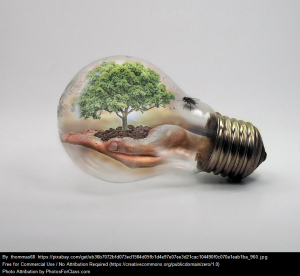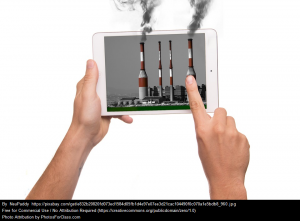Becoming a Climate Leader
by Professor David Fallick
 The National Oceanic and Atmospheric Administration’s Climate Stewards Education Project (CSEP) was a program for teachers (now called the Planet Stewards Education Project) designed to help teachers prepare students to respond to environmental challenges. Its educational component for teachers included “webinars” on various climate and climate change topics and, less often, workshops in person. In order to receive the CSEP certificate, participant teachers had to carry out individual projects, which they developed with the input of cohort members and a cohort leader. Since our members (all teachers) lived in different states, the cohort “meetings” were held virtually. I carried out my project in the fall of 2016 on the Rockville campus with the Student Life office as the sponsor. Doing my individual project with students was one of the most important and meaningful things I have done at Montgomery College. I showed a group of 12 individuals how to reduce their carbon dioxide emissions, and, in six weeks, they alone avoided an approximately 4440.18594- to 4845.78594-pound carbon dioxide contribution to the most significant human-made impact, climate change, on this perfect life-sustaining planet we inherited. Including the efforts of those friends and family members that the 12 students recruited by the end of the project to participate in reducing emissions, approximately 6085.59694 to 6491.19694 pounds of carbon dioxide emissions into the atmosphere were avoided as a result of this project.
The National Oceanic and Atmospheric Administration’s Climate Stewards Education Project (CSEP) was a program for teachers (now called the Planet Stewards Education Project) designed to help teachers prepare students to respond to environmental challenges. Its educational component for teachers included “webinars” on various climate and climate change topics and, less often, workshops in person. In order to receive the CSEP certificate, participant teachers had to carry out individual projects, which they developed with the input of cohort members and a cohort leader. Since our members (all teachers) lived in different states, the cohort “meetings” were held virtually. I carried out my project in the fall of 2016 on the Rockville campus with the Student Life office as the sponsor. Doing my individual project with students was one of the most important and meaningful things I have done at Montgomery College. I showed a group of 12 individuals how to reduce their carbon dioxide emissions, and, in six weeks, they alone avoided an approximately 4440.18594- to 4845.78594-pound carbon dioxide contribution to the most significant human-made impact, climate change, on this perfect life-sustaining planet we inherited. Including the efforts of those friends and family members that the 12 students recruited by the end of the project to participate in reducing emissions, approximately 6085.59694 to 6491.19694 pounds of carbon dioxide emissions into the atmosphere were avoided as a result of this project.
The title of my project was Become a Climate Leader – Lead the Way to a Better World. It dealt with two issues: 1) the reduction of carbon dioxide emissions and 2) climate change/mitigation education and individual behavior change. The students made an effort to change their behavior in a number of ways in order to reduce their carbon dioxide emissions. This reduction was recorded as pounds of carbon dioxide emissions avoided. In order to collect this data, the students needed to find out the wattage of appliances and light bulbs and the miles per gallon for their vehicles and the miles that they drive over a chosen time period. Then, they needed to record how many hours less a certain appliance or light bulb was used and how many fewer miles were driven. One individual reduced gasoline usage not by driving less but by switching to a more fuel-efficient vehicle. Therefore, his calculations were based on the difference between the miles per gallon of the two vehicles. To calculate carbon dioxide emissions reductions through showering, estimates had been made based on sources recommended by our school’s energy manager. For reductions by using air conditioning less, the estimated power of the air conditioner was given to us by a faculty member in Building and Construction Technology in Continuing Education & Workforce Development. His estimate of the power of the unit was used because the student could not find the power of the air conditioner on her own or with help from the maintenance man at her apartment building.
Below are detailed figures of the carbon dioxide emissions. All amounts should be seen as the closest estimate available to us. Each entry represents one student’s emissions reductions. The number after the word “Student” (for example, “Student 1”) does not refer to the same student throughout all reduction activities. The numbers show the number of students participating in one particular activity.
Pounds of CO2 Emissions Avoided due to Gasoline Use Reduction by Reducing Miles Driven*
*(Student 6 reduced gasoline use from switching from driving a truck to driving a car.)
| Student 1 98.47 |
| Student 2 21.43 |
| Student 3 1167 |
| Student 4 38.13 |
| Student 5 205.88 |
| Student 6 612.24 |
Subtotal = 2143.15
Reducing hairdryer use
| Student 1 21.0192 pounds |
| Student 2 2.2815 pounds |
Subtotal = 23.3007 pounds
Turning off personal computer and monitor
| Student 1 103.42 pounds (had personal computer and monitor off 220 hours more than before) |
Subtotal = 103.42 pounds
Reducing light-bulb use
| Student 1 1.19 pounds (30 hours off) |
Subtotal = 1.19 pounds
Reducing shower time
| Student 1 1093.95 pounds (143 minutes less in the shower) |
| Student 2 459 pounds (from not bathing pet dog) |
Subtotal = 1552.95 pounds
Turning TV off
| Student 1 3.05 pounds (13.25 fewer hours on) |
| Student 2 3.3462 pounds (39 fewer hours on) |
| Student 3 1.37904 pounds (30 fewer hours on over two weeks of the project) |
Subtotal = 7.77524
Not using air conditioner
| Student 1 608.4 pounds to 1014 pounds (This is a range due to needing to estimate the power of the air conditioner [3 kW- 5 kW]) |
Subtotal = 608.4 to 1014 pounds
Total = 4440.18594 pounds to 4845.78594 pounds
Recruits’ reductions
The students’ recruits (that is, others whom they got involved in reductions) reduced their emissions between the third and the last meetings, a two-week period.
Gasoline use reduction
| Recruit 1 1071 pounds |
| Recruit 2 165 pounds |
Subtotal = 1236 pounds
Reducing hairdryer use
| Recruit 1 17.4408 pounds (for two people) |
| Recruit 2 1.014 pounds |
Subtotal = 18.458
Reducing shower time
| Recruit 1 183.6 pounds |
| Recruit 2 206.55 pounds |
Subtotal = 390.15
Turning TV off
| Recruit 1 .803 pounds |
Subtotal = .803 pounds
Recruits’ Total = 1645.411
Grand Total (Participants + Recruits) = 6085.59694 pounds to 6491.19694 pounds
Benefits of the Project
The benefits of this project to the students were as follows:
- The students gained knowledge of the climate change problem (its causes, effects, and mitigation).
- They now know how to calculate carbon dioxide emissions.
- They are now aware of their actions that contribute carbon dioxide to the atmosphere and how these actions produce carbon dioxide emissions.
- They have the knowledge and ability to mitigate their carbon dioxide emissions for the rest of their lives. Therefore, they can play an active role in the mitigation of climate change forever.
- They can show others how to reduce their carbon dioxide emissions, bringing more people into active mitigation of climate change
Suggestions for Others to Replicate This Workshop
With enough self-study and help from others, it is possible and also fairly easy to teach others how to reduce their carbon dioxide emissions, have them do so, and to  collect data as to how many pounds of carbon dioxide have been avoided. It is also low cost. My expenses were for books (Cooler Smarter by the Union of Concerned Scientists, T-shirts (“NOAA Climate Stewards – Climate Leader”), tote bags (with the words “I’m on a Mission to Reduce My Emissions”), buttons (with the words “Ask Me about Climate Change”), and refreshments. These items were actually not necessary for the students to implement their carbon-dioxide-reduction behaviors and to collect data. Therefore, this project can be done virtually for free.
collect data as to how many pounds of carbon dioxide have been avoided. It is also low cost. My expenses were for books (Cooler Smarter by the Union of Concerned Scientists, T-shirts (“NOAA Climate Stewards – Climate Leader”), tote bags (with the words “I’m on a Mission to Reduce My Emissions”), buttons (with the words “Ask Me about Climate Change”), and refreshments. These items were actually not necessary for the students to implement their carbon-dioxide-reduction behaviors and to collect data. Therefore, this project can be done virtually for free.
It is important to rely on those with more expertise than oneself in this area. The Montgomery College energy manager was helpful in a critical way in terms of working with me to come up with the methods for calculating the carbon dioxide reductions in the form of the formulas below. He checked and/or corrected some of the formulas and provided others to me out right. The faculty member in Building and Construction Technology provided the estimated range of power for an apartment air conditioning unit.
It is important to go over students’ data in case there are errors that need to be corrected.
The benefits of this project were/are immense. Climate change is the major problem of our day, changing life as we know it. Aside from the thousands of pounds of carbon dioxide emissions avoided during the workshop, this group of 12 participants can now independently continue reducing carbon dioxide emissions and spreading the word to others. This workshop also provided an opportunity for these students to act upon their concern learn about climate change, and become active in its mitigation.
This project can be replicated by other teachers and done with many more students, as well as staff, faculty, administrators, and community members.
Appendix of Formulas Becoming a climate leader
In March 2019, Professor Fallick will be offering a workshop at the Pennsylvania Association of Environmental Educators for teachers to implement this training for students.


